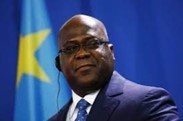Not only is there Brazzaville, Congo and Kinshasa, Congo representing two separate countries, Kinshasa, Congo is in effect two very different Congo entities. The capital, Kinshasa, has high rise hotels representing islands of order and calm scattered among a sea of great poverty, chaos, and death. On the other hand, one does not have to venture too far out of Kinshasa to encounter an entirely different environment with little rule of law and a population subject to the control of different guerilla armies. The United Nations has varying degrees of troop presence in some of the areas, but they go to great lengths to avoid engagement with the guerrilla forces. The highly touted mineral riches just happen to be in the areas outside the reach of Kinshasa.
President Tshisekedi of Kinshasa, Congo is planning a trip to visit the usual suspects in the Middle East to promote investor interest in Congo’s valuable mineral interests that could play a major role in the transition from the current fossil fuel riches of much of the Arab world. However, apart from diplomatic courtesy, there seems to be very little genuine Arab interest in participating in that opportunity. Certainly, the sheikhs are not beating down the door to capture cobalt deposits like the Texan and mercenary cowboys who keep the action going in Kinshasa. On the other hand, money talks but the Arabs have a solid footing in the existing oil world which they are not eager to see die a premature death.

Over a month ago, neighboring Uganda invaded eastern Democratic Republic of Congo following air and artillery strikes. Recently, The New York Times published an article entitled Why Did Uganda Send Troops Into Congo? Judging from the “one size fits all” concept of the Uganda military uniform design shown below, the troops are not that visually intimidating. Nonetheless, it is always a bit unnerving when one neighbor invades another. The alleged villain is the Allied Democratic Forces, which is a well-established terrorist organization with significant control over that portion of Congo. President Tshisekedi of Congo has described the invasion as a temporary joint operation to bring some measure of stability into the eastern part of his country. As he is up for re-election next year, it does not help his image to have the resource-rich portion of his country held by rebels.

While the Ugandan troops seem to lack style in their uniforms, the Congolese leader, on the left below, shames them with his red epaulets and green beret. You will note that the Ugandan officer to his right has the physical build to look properly attired in the “one size fits all” uniform. However, it should come as no surprise that the Congolese have style but do not have the capability to control the 120 or so rebel armed groups in Eastern Congo.

The Ugandans came rolling in with their tanks, as shown below, which is plenty of fire power to handle a “rumble in the jungle.” On the other hand, there must be a lingering concern that the Ugandans may want to begin a new chapter of natural resource capture and exploitation in the Congo following their great success in the development of major oil fields to the north and east in Uganda. Allegedly, the Ugandans are greatly concerned that the rebel armies will disrupt their oil exports to neighboring countries which underscores their logic to invade Congo. Oil was discovered in 2006 in the Albertine Graben of Uganda. Development of the large discovery of some 2.5 billion barrels will require $20 billion in investment and will have to overcome environmental issues as well as rebel insurrection from the DRC.

Following the oil discoveries to the north in Uganda, we chose to pursue the concept of a potential extension of the oil accumulations to the south on the Congo side in what was a territory filled with bad guys. We were instructed by the Congolese government to officially retain Major Ferusi of the Congolese army, standing next to me below, and his band of merrymen with 50 caliber machine guns, to be our security detail. At the end of the day, given the efforts of “Fear No Beer” Bob and Vinny in his Irish camo shirt, we determined that the oil resources are most likely there but recovering them will be costly beyond any realistic economic measurement and most probably dangerous. Therefore, we returned safely back to Uganda with Major Ferusi and his convoy.

Perhaps Uganda even has personal risk as well since the next day we gringos were walking around Kampala when, suddenly, I could not breathe and went blank. I awoke a few seconds later to realize I was being dragged down the street. It turns out a strong local had noticed the gold chain around my neck, grabbed it from the back thinking it would break, and he would be long gone with the gold loot. What he did not realize was that it was 24 caret gold with an ancient Buddha image that had withstood more than that punk could deliver. My mates realized I was MIA and ran back to save the day. When you have Buddha, your mates and 24 caret gold in the same corner, you are “ten feet tall and bullet proof.”
In another somewhat marginally recovered war zone in western Kinshasa, Congo, we believed it was better to fly and not drive through guerrilla territory. However, we experienced another situation shown below that caused us to re-think why we were in that part of the world. Aviation basics require wheels down on landing which is an important detail.

Here comes the question—Why have we followed such a potentially hazardous path? First, we have discovered very significant quantities of oil in many parts of the world and made some money for us and our shareholders. Second, we have had spiritually uplifting social, welfare programs everywhere we have gone. Why is that? We have found that our lives in those places are enriched by being members of the communities. Third, why keep going after all these years? We have one more potential big discovery to drill in the next eighteen months in Vietnam where we have been active and successful for some thirty years. Another large oil discovery there would back out the environmentally harmful alternate energy source of coal until affordable options to fossil fuels in that part of the world can be economically developed. Stay tuned for big news!

Explore our collection of hand-painted cards from Thailand and pop-up cards from Vietnam. Unique works of art for every occasion.

